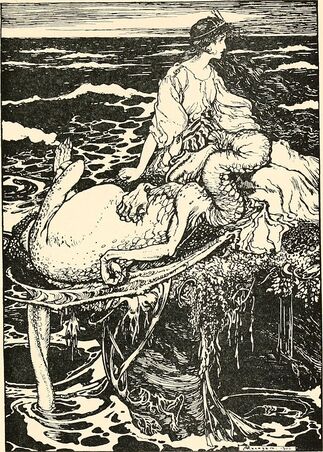|
There's a popular conception that fairytales all take place a very long time ago, in ancient times with princesses and castles and knights. That's partly true. But then why are there no "modern" fairytales?
I believe most people who told oral folktales, while they may have featured princesses and castles and so on, pictured the events as happening in towns like their own, with technology like their own. Contemporary settings. Folktale collecting's major boom began around the early 1800s with the Brothers Grimm. We also had a wave of fairytale writers, like Hans Christian Andersen, inspired by folktales. The result of the folklore movement was fairytales frozen in time. Now that they were in print, they existed as the product of that time period. Just for context, the telegraph was invented in 1837. The first telephone was 1876, the light bulb 1878. You had Napoleon, the Louisiana Purchase, the American Civil War (in no particular order). People living in the 1800s would have lived to see the first films and World War II. The image at the top of this post is an illustration of the Grimms' tale "The Four Skillful Brothers." It looks very fantastical and medieval, right? That looks like the kind of dragon you'd slay with a sword. Spoiler alert: someone shoots that dragon with a gun. Guns actually appear a lot of fairytales, from the Grimms and otherwise. You see the same thing in literary fairytales like Hans Christian Andersen's. In Andersen, there's a wide range. The Marsh King's Daughter features Vikings, but The Steadfast Tin Soldier has tin soldiers, muskets, ballet, and plumbing. Today, there's a sort of "fairytale canon" in the popular mind, strongly influenced by Disney. Even Disney fairytales tend to be set in a vague, anachronistic past. For instance, Snow White is a mishmash of elements from different historical periods. Their clothing is medieval fantasy, but there's gas technology and a Bunsen burner in the Evil Queen's lair. The Bunsen burner was invented in the 1850s. Are there any modern fairytales set in modern times? It depends on what you mean. Although oral storytelling isn't as popular, we do have people continuing to retell and adapt fairytales as movies or as books. In many cases, these retellings are set in contemporary times. See Cinder Edna, a picture book by Ellen Jackson, where the main character takes a bus to the ball. There are also plenty of fantasy short stories which have modern flavors. Or even Internet folklore like Slenderman. But I do think that if you set out to collect oral folktales being told today, you will find fairytales set in worlds like those the storytellers inhabit. There are collections created well into the 20th century. Hasan el-Shamy has collected folktales from the Middle East. Another example is Barbara Rieti's Strange Terrain: The Fairy World in Newfoundland, published 1991. At one point in 1985, she attempted to track down the origins of a local tale of a little girl taken away by fairies. You would think of that as happening in a long-ago distant time - which Rieti initially did. But then she actually met the person involved, who was then in her sixties (and who did not seem happy at her experience being turned into a fairytale). She had been lost in the woods for over a week and suffered from hypothermia. This happened in the 1930s. I think there's a Disney-influenced imagining of fairytales as all taking place in the distant past, further influenced by a lack of context for just how recently these tales were set down in print. Text copyright © Writing in Margins, All Rights Reserved
4 Comments
Sarah D
11/8/2020 10:02:14 pm
This idea is blowing my mind. I have been trying to decide what era the fairy tale I am writing takes place in so I can get all the facts and details correct, but now... It can be whatever I want? A vague, anachronistic past!! I don't have to worry about getting things right!? Things that are technically correct may seem out of place... amazing!
Reply
Oliver
10/25/2022 10:02:57 am
this couldve been summarized in a single sentence.
Reply
Daniel
2/3/2023 03:00:08 am
While that ill-defined fairy-tale past often has medieval elements (knights and dragons) I've noticed that the fashions shown in its visual depictions of balls and nobility often track a bit closer to the time those tales were originally written or transcribed from oral tradition. So, while they might have been written in the 1800s, the illustrators and costume designers since have often thrown the fashions back to the swashbuckling 1700-1600s.
Reply
katrina
2/12/2024 11:13:44 am
lol i was just looking for a time or era to place a fairytale i wanna write.. okayyy this has a nice meaning but i just wanted a answer.
Reply
Leave a Reply. |
About
Researching folktales and fairies, with a focus on common tale types. Archives
July 2024
Categories
All
|
Writing in Margins

 RSS Feed
RSS Feed
